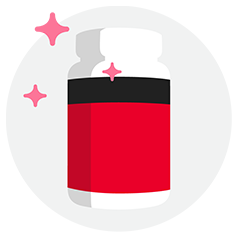Spotting the symptoms of fungal overgrowth
Created on: January 19, 2021

Fungi, bacteria and other cells are elements that make up the human body. When there’s a healthy balance between host cells, bacterial and fungal organisms, this happy trio works seamlessly. But troubles can occur when this balance is disrupted. Changes in host immunity, stress, altered gut microbiota and other factors can lead to fungal overgrowth. This can cause a wide range of infections, from the benign to the potentially life-threatening. Researchers continue to find new, natural ways to prevent and fight back against fungal and yeast overgrowth.
What is yeast overgrowth?
There are many types of fungi that live in and on the human body. The most prevalent species is Candida albicans, or Candida for short. Candida is found in many areas of the body, including the mouth, skin, gastrointestinal tract and genitourinary system, which includes the genitals and urinary tract. At normal levels, candida is harmless. However, under certain circumstances, candida may grow uncontrollably and cause fungal infections, known as Candidiasis. In fact, this type of yeast overgrowth is the most frequent cause of fungal infections in humans.
Why does fungal overgrowth happen?
Normally, the healthy bacteria in your body keeps Candida levels under control. But when ideal bacteria levels dip or are disrupted, or when the immune system is weakened, yeast begins to take over, bringing with it a multitude of health consequences.
Common reasons for fungal overgrowth
There are several reasons for fungal overgrowth to occur, and here are some of the most common among them:
- Use of antibiotics, which kill good bacteria along with the bad
- A compromised immune system (this can be due to HIV, AIDS and some forms of cancers)
- Use of oral contraceptives, which may alter the composition of the vaginal microbiome
- Diabetes, due to higher blood glucose levels
- Increased stress
- Inflammation
The top Candida overgrowth signs and symptoms
Candida overgrowth comes with an array of detectable symptoms. If you experience any of the following, you may have candida overgrowth:
- Oral thrush: White, bumpy patches may develop in the mouth or throat as a result of candidiasis, affecting the tongue, inner cheeks and gums. Oral thrush can cause redness, soreness and light bleeding.
- Fatigue: Since yeast overgrowth affects the gut microbiome, nutrient absorption and assimilation may be compromised. This can lead to chronic fatigue and tiredness, lowered immune defence and inflammation.
- Recurring vaginal yeast infections or UTIs: Vaginal candidiasis causes redness, swelling, intense itching, pain during intercourse and vaginal discharge. Candida related urinary tract infections may cause a burning sensation during urination, a frequent urge to urinate, along with cloudy urine and pain in the lower abdomen.
- Digestive issues: Symptoms of digestive issues such as constipation, diarrhea, bloating, gas, mucous in stool, as well as conditions like Crohn’s disease, ulcerative colitis and inflammatory bowel disease are associated with candida overgrowth. Experts haven’t yet established whether Candida causes digestive issues, or if pre-existing digestive issues foster the growth of Candida, although it’s likely that both are true.
Fighting fungal overgrowth naturally
Whether your goal is to prevent fungal overgrowth, nip it in the bud before it blooms, or fight it off effectively, natural remedies are a worthwhile option. Conventional treatments such as azole antifungals have been extensively associated with fungal resistance, thus threatening their efficacy and heightening the risk of dangerous infection. However, natural remedies offer a ray of hope.
Try these herbs and nutrients to help fight yeast infections and promote a healthy gut.
Olive Leaf Extract: Polyphenol and other phenolic compounds abundant in olive leaf extract have been studied and found to be potent anti-inflammatory and antioxidant agents which may help fight and reverse damage associated with fungal overgrowth.
Caproil: Antifungal calendula (Calendula officinalis) blends with yeast fighting coconut oil in the form of caprylic acid. Calendula contains naturally occurring triterpenoids, flavonoids, bitter resins, volatile oils and immuno-stimulating polysaccharides. These and other phenol compounds are actively studied for their anti-Candida activity.
Licorice: A time-tested herbal remedy, licorice lines the mucous membranes of the digestive tract with a healing and protective layer. It helps bolster production of mucin, a protein that may protect against harmful pathogens such as Candida.
Psyllium + Fibregum: A healthy fibre source combining both soluble and insoluble fibre, such as psyllium and acacia fibre, helps fight inflammation, supports blood sugar balance, enhances detoxification and elimination and protects the lining of the digestive tract. This offers myriad layers of protection against Candida and yeast overgrowth.
Probiotics: Beneficial gut bacteria have the potential to guard against all harmful pathogens and microbes, maintaining host defence and general health. The clinical strain of Lactobacillus acidophilus probiotics proves to reduce the likelihood of Candida bloom and its harmful effects.






